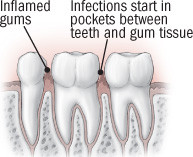Brushing up on brushing
Who needs to be advised on how to brush their teeth? More of us than you might think. Seven suggestions on the right way to clean your teeth.
Toothbrushing may be the most ingrained of all health habits. We take a toothbrush with us when we travel. Most people can't imagine getting through a day without brushing at least once and probably twice. And there's apparently enough money in it to make expensive advertising campaigns worthwhile. Imagine if other health habits — exercise, eating whole grains, getting enough sleep — had the ad budgets of Crest or Colgate?
But just because we do something often doesn't mean we do it right — and there's lots of bad brushing going on. An inadequate job leaves behind the bacteria-laden plaque — the whitish stuff that collects in between teeth and near the gum line — that causes cavities and gum disease.
Overzealous brushing is a problem, too, scraping away tooth structure and damaging gum tissue so it loses its nice, tight grip on teeth and opens the door to infection and serious gum damage.
Here are seven tips about toothbrushing that may help you to do a better job of keeping teeth clean.
1. Brush longer than you think you need to. Studies have shown that most people claim they brush for two to three minutes when they've actually spent about half that time. A good, thorough brushing takes at least two minutes whether you are using a manual or powered toothbrush.
2. Work systematically. People often spend more time on their front teeth, and there's some lore that right-handed people neglect the right side of their mouth and left-handers the left side. Some dentists recommend dividing the mouth into quadrants and moving methodically from the upper right to the upper left to the lower right and then to the lower left. The order doesn't matter so much as being thorough.
3. Use a brush with soft bristles of varying height. Soft bristles are easier on the teeth and gums and may do a better job of cleaning between teeth. Most brushes are advertised as having soft bristles, but companies are free to define softness as they wish, so you may need to experiment a little. Toothbrushes used to be made so all bristles were the same height. Now many have bristles that vary in height. It's been shown that such a design may improve cleaning between teeth and of the sulci, the tiny pockets between the teeth and the gums.
4. Change your brush at least every three months. When the bristles splay, they're less effective. And a worn-out toothbrush is more likely to harbor oral bacteria that will get reintroduced into your mouth every time your brush. You should replace your toothbrush every three months or so.
5. Manual can be just as good as electric, but... According to Dr. David Kim at the Harvard School of Dental Medicine, many studies have shown that manual brushing can be just as effective as using a powered toothbrush. But Dr. Kim, who has done some research for Philips, one of the powered toothbrush manufacturers, says the powered brushes may be more efficient and possibly do a better job of cleaning between teeth. Older people may want to switch to a powered brush if they've lost hand strength and dexterity because the handles are larger, and the brush does some of the work for you.
Some deluxe models sell for over $100, but you can also buy a battery-powered toothbrush these days for about $6. Still, sticking with manual brushing can save you some money, and your oral health will be none the worse for it, provided that you put in the requisite time and effort.
|
Mind the gaps
Brushing and flossing prevents gum disease between teeth. |
6. If your technique is working, just stick with it. If you wander into the world of toothbrushing research, you find that there are many techniques, most named for their proponents. So there's the Bass method (bristles at a 45-degree angle, short vibrating motion), the modified Bass method, Fone's (circular motion), Charter's (bristles at a 90-degree angle and pushed in between teeth) and Leonard's (the simple up and down scrubbing that many of us grew up doing). But toothbrushing is one endeavor where the end should justify the means. If you're getting good results, just stick with what you're doing. If you're not, perhaps your dentist or the hygienist will make some helpful suggestions.
7. And don't forget to floss! This is the second commandment of dental hygiene after "brush regularly." Manual brushing can't reliably clean between the teeth. Powered toothbrushes may do a better job, but they don't eliminate the need to floss. Acquiring the flossing habit can be difficult, particularly for those of us who were reared on the brushing message. Telling yourself to set aside enough time to brush and floss may help. Try a little self-inflicted guilt. Tell yourself you're not doing a good job unless you floss.
Disclaimer:
As a service to our readers, Harvard Health Publishing provides access to our library of archived content. Please note the date of last review or update on all articles.
No content on this site, regardless of date, should ever be used as a substitute for direct medical advice from your doctor or other qualified clinician.













